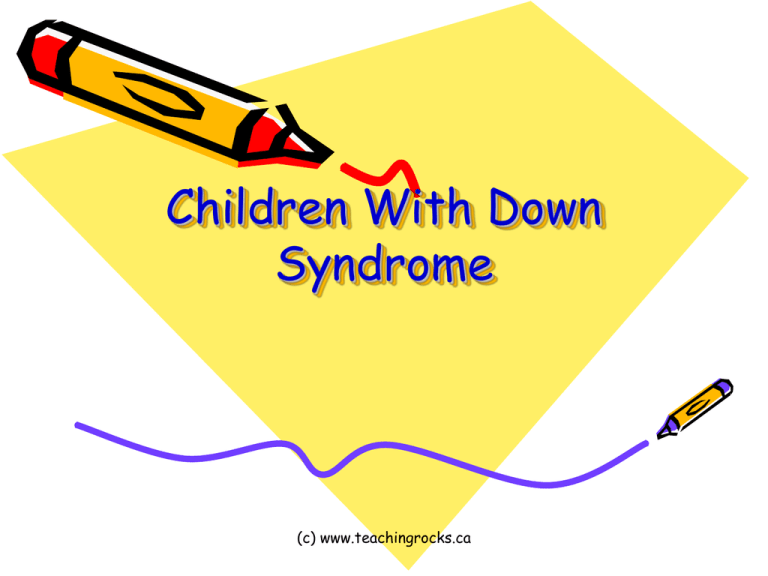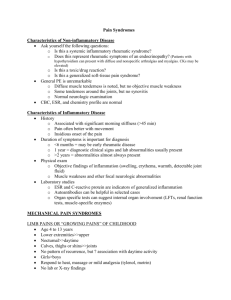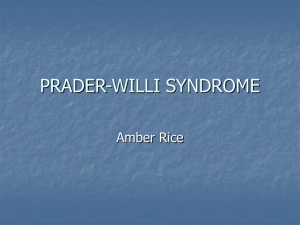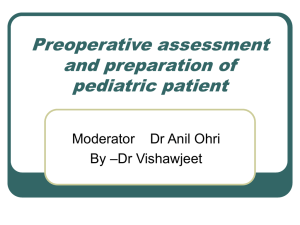Children-With-Down-Syndrome
advertisement

Children With Down Syndrome (c) www.teachingrocks.ca Creed of Babies With Down Syndrome My face may be different But my feelings the same I laugh and I cry And I take pride in my gains I was sent here among you To teach you to love As God in the heavens Looks down from above To Him I’m no different His love knows no bounds It’s those here among you In cities and towns That judge me by standards That man has imparted But this family I’ve chosen Will help me get started For I’m one of the children So special and few That came here to learn The same lessons as you That love is acceptance It must come from the heart We all have the same purpose Though not the same start The Lord gave me life To live and embrace And(c) I’ll www.teachingrocks.ca do it as you do But at my own pace What is Down Syndrome? (Definition) Down Syndrome, also known as Trisomy 21, is the most commonly recognized disorder found in children. It is a genetic disorder, resulting in an extra 21st chromosome. This error in the “blueprint” of the body usually causes delays and limitations in physical and intellectual development. The extra chromosome may be derived from either the egg or the sperm. The incidence of Down Syndrome in the general population is one in every 900 births and is not related to race, religion, nationality, or socio economic status. (Paasche , p.87) (c) www.teachingrocks.ca Causes: The most common cause of Down Syndrome occurs when an infant is born with three, rather than two, copies of the 21st chromosome (known medically as trisomy 21). Normally there are 46 chromosomes (23 pairs), half of which are inherited from each parent. Children with Down syndrome, however, have cells that usually contain not 46, but 47 chromosomes, the extra one being a third chromosome 21. It is this extra genetic material in infants with Down Syndrome that disrupts their physical and cognitive development. http://k-idshealth.org/parent/medical/genetic/down_syndrome.html (c) www.teachingrocks.ca Behavioral Characteristics: - significant delay in nonverbal cognitive development - specific deficits in speech, language production, and auditory short-term memory - heart defects - intestinal abnormalities - hearing impairments - cognitive delay, ranging from mild to severe - delays and limitations in physical and intellectual development http://kidshealth.org/kid/health_problems/birth_defect/down_syndrome_p2.html (c) www.teachingrocks.ca Physical Characteristics: - relatively small head that appears somewhat flattened in the back - low bridge of the nose, giving a flat mid-faced appearance - small, low-set ears with unusually shaped earlobes - short fingers and toes - a single, almost straight line across the upper part of one or both palms, instead of the usual pair of parallel lines -curving folds of skin at the inner corners of the eyes, which give an almond shape to the eyes - broad neck -excessive ability to extend the joints -fifth finger has one bending joint instead of two -excessive space between large and second toe - enlargement of tongue in relationship to size of mouth (c) www.teachingrocks.ca Treatment Options: Unfortunately, there is no specific treatment for Down Syndrome. Children with Down Syndrome are born with an abnormal number of chromosomes, therefore, there is no cure, and is something they have to live with all their lives. However, there are countless treatments and medical procedures available to help children with Down syndrome: - Developmental Pediatricians - Pediatric Physical Therapists (can help gain large muscle control) - Pediatric Occupational Therapists (can help gain smaller muscle control) - Speech and Language Therapists - Nutritional Therapists - Tubes can be implanted to increase hearing abilities The above mentioned can significantly change the quality of life for these children. http://www.ncbi.hlm.hih.gov/entrez/query.fcgi?cmd=retreieve&db=pubmed&dopt.html (c) www.teachingrocks.ca Possible Implications in the Classroom – – – – – – – – – May have difficulty remaining seated Excessive climbing and running Difficulty playing quietly Fidgets Blurts out (if verbal) Interrupts, intrudes Can’t wait their turn Impedes academic achievement Nature and educational implications is rarely part of teacher training – Teachers are still expected to help these students learn and achieve academically (c) www.teachingrocks.ca Specific Accommodations: • Physical Arrangement of Class: The classroom should provide adequate space for children with Down Syndrome, to move around freely , if any tantrums should occur. There should be a quiet area, such as the carpet area where the children can go to soothe and relax themselves, when feeling upset, frustrated and sometimes aggressive. There must be a lot of open space, in means of having equipment pushed to the outside of the classroom, as well as having the doorway clear at all times, for children with Down Syndrome love to run and have habits of running around and out of the classroom. (c) www.teachingrocks.ca •Adapting Furniture The furniture within the classroom should be appropriately sized for the age of the children within the classroom The furniture must be free of any sharp or rough edges, as the children love to explore their surroundings and the objects around them The furniture within the classroom should also have extra padding , such as having pillows or padding at the carpet area, as the children have tendencies to bang their heads or throw themselves down to the floor (c) www.teachingrocks.ca •Teacher supported or instructional activities An educational assistant should be available for the child at all times, to help them complete hands on activities, and work such as writing, arts and crafts, cutting and pasting Depending on the level of the child, some may need assistance when eating, as they tend to put too much in their mouths which can cause choking Teacher must be by their side in times of transitions, or outdoor play, as they need guidance and tend to take off or run away when not accompanied by someone There should be visuals in the classroom indicating schedules, routines, instructions, which may include short, common or familiar terminology, again depending on the level of the child as some may be more independent then others (c) www.teachingrocks.ca Maximizing independence in routines: The teacher within the classroom should always promote and encourage independency among children with exceptionalities, as most children like to do things on their own During activities, child should be given things they can work on, on their own and at their own pace Examples can be shown to show child how things are done such as showing them how to cut, giving them scissors, and then letting them try on their own With eating, teacher does not have sit with the child at all times, rather show the child how to eat by picking up a piece of food, putting it in their mouth and then letting the child try for themselves on their own. If assistance is needed, teacher should know when to move in (c) www.teachingrocks.ca Visuals can be posted in the classroom to show children what will come next for the day, so they do not need to be told constantly, they can become aware of transitions, and they can then have something to look forward to which builds a sense of routine for the child When walking, or outdoors, teacher should always be in view of the child, but allow the child to freely move around on their own, as it would not be fair for the child to hold their hand and keep them close by. In times of tantrums, the teacher should allow the child to be on their own by allowing space for the child, to which they know they can turn to when they want to be on their own. Teacher should be available, though, to help guide and soothe the child , and be aware of the restrictions of the child or when the child may need them (c) www.teachingrocks.ca Building social interactions with peer group Providing an inclusive environment is extremely important During circle time, activities, or class lessons, the child should be included as part of the group ratio, in means of being a part of the group in terms of participating. Back at the desks, the child should be included with the arrangement of group of desks, so the child has the opportunity to engage in interaction with the other children in the classroom, and other children can get to know them (c) www.teachingrocks.ca From time to time, the arrangement of desks may change, therefore, the child should also be included in the change of arrangement so they can move around the classroom and get to know each of the other children Including the child as part of the change, can help the child grasp the concept of transitions, change, and become more familiar to it, which will allow it to be easier for them as time passes them by. (c) www.teachingrocks.ca Other classroom strategies… • Give immediate feedback • Avoid multi-task assignments • Use positive feedback when student has complied and whenever possible • Use praise and reward for desired behavior • Simplify the more complex tasks • Use structured materials, direct instruction and programmed learning • Use preferential seating • Try to teach more difficult subjects which require more thinking in the mornings such as math or spelling (c) www.teachingrocks.ca • Be flexible and modify classroom expectations when necessary • Avoid power struggles • Space short work periods with breaks • Provide additional time to complete work • Allow extra time for homework completion • Inform student with several reminders, several minutes apart, before changing from one activity to the next • Give alternatives • Number and sequence steps in a task • Provide outlines • Allow oral administration of test (c) www.teachingrocks.ca Assessment Techniques: Tests • Provide a quiet setting for test taking • Allow tests to be scribed and allow for oral responses • Divide testing into small sections • Grade spelling separately from content • Allow necessary time to complete • Avoid time test • Permit retaking the test • Provide monitored breaks from test (c) www.teachingrocks.ca Personal Observation - Anecdotal records - Record academic related behaviors - Teacher made checklists Student-Centered Assessment Strategies - Think aloud techniques, self evaluation, interviews and student journals or learning logs (c) www.teachingrocks.ca - - Working With Families/Parents Encourage parents to bring in things from home into the classroom so that the child can easily recognize/relate (link home to school from day one) Meet with parents before the school year starts Make promises that can be kept Consistency throughout the year both inside and outside the classroom (on a daily basis) Consistent communication between parent/class teacher/administration and school staff (keep a daily log/journal) Teachers should reassure parents that they will gain knowledge and develop a strong understanding of the child’s exceptionalities so that they are better able to integrate and include child into the classroom Encourage peer interactions both inside and outside the classroom (c) www.teachingrocks.ca • Discuss re-enforcement programs such as peer buddies; whether they support it • Develop/create visual schedules with parents • Discuss various techniques and strategies that work best for the child; as well as, implement new ones and share them with the parent • Send home activities/work that has been completed during class so that child learns to link home and school (repetition and consistency) • Notify parents which peers their child is strongly connected to, so that it encourages communication among peers outside the classroom • Important to create connections with the child • Important to learn and gain knowledge, awareness of the exceptionality, as well, to get involved (c) www.teachingrocks.ca • Work with the parents • Communication between home, staff, administration, teams= success • Do the same things as with every other child, while also doing some things differently (depending) • Communication boards, visuals, gestures • Raise awareness within the classroom among students, as well as, outside the classroom among parents, guardians, etc. (allows individuals to seek ways in which they can help or get involved) • Be patient and understanding • Be helpful but not TOO helpful; encourage independence (know when to intervene) • Provide resources from within the school for parents (make them available) (c) www.teachingrocks.ca • Be open to learn new things • Don’t be afraid to ask when you don’t know (parents/other teachers/principals) • Be sensitive to students needs (including that of the siblings of the child with exceptionalities) • Needs of a child ALWAYS come first • Be aware that some parents do not have any other resources but their child • Do not talk about the child as if they are not there, include them in any discussion you deem appropriate (c) www.teachingrocks.ca The story of ‘J’ (5 yrs old) (c) www.teachingrocks.ca • • • • • • • • • • • • • • • • • • Initial Observations Follows routines well Accommodates change easily Non-verbal Points to things he wants or needs Plays well, interacts nicely with other children Can color, though attention span is limited Imitates sound well, can repeat sounds Works independently Knows his colors, distinguishes shapes Traces straight lines, problems with curves/zig zags Favors left when cutting, but right when coloring, tracing Sits well, independently, but not for long periods of time Bangs head on floor or walls when does not get what he wants Runs quickly and slowly Walks on his own Climbs chairs, tables, desks At times, does not focus nor pay attention Puts on, takes off jacket, grabs his own bag (c) www.teachingrocks.ca Goals expand attention span - help prevent child from becoming frustrated which would then prevent banging of the head - Enhance fine motor skills ( tracing lines of all shapes) - Encourage development of language skills - Maintain social skills - Guide child in writing letters and numbers - Word recognition - enhance gross motor skills - Comprehension of when to run and when to walk, what he can climb (c) www.teachingrocks.ca Activities Created Expand attention span – finger plays, listening activities/sound pictures, story telling Gross motor skills – balance beam/ bouncing ball Fine motor skills- repetition of tracing shapes with dotted lines, string beads, picking up small objects such as rice/pasta, hole puncher, writing with a thicker pencil to start Receptive: pictures with corresponding words/ sound, having child point to objects to test word recognition then showing picture, repeating simple words so child can become more familiar of the sound it makes Visuals: schedules, daily routines, tasks for the day such as washing hands, washroom, etc. (c) www.teachingrocks.ca











